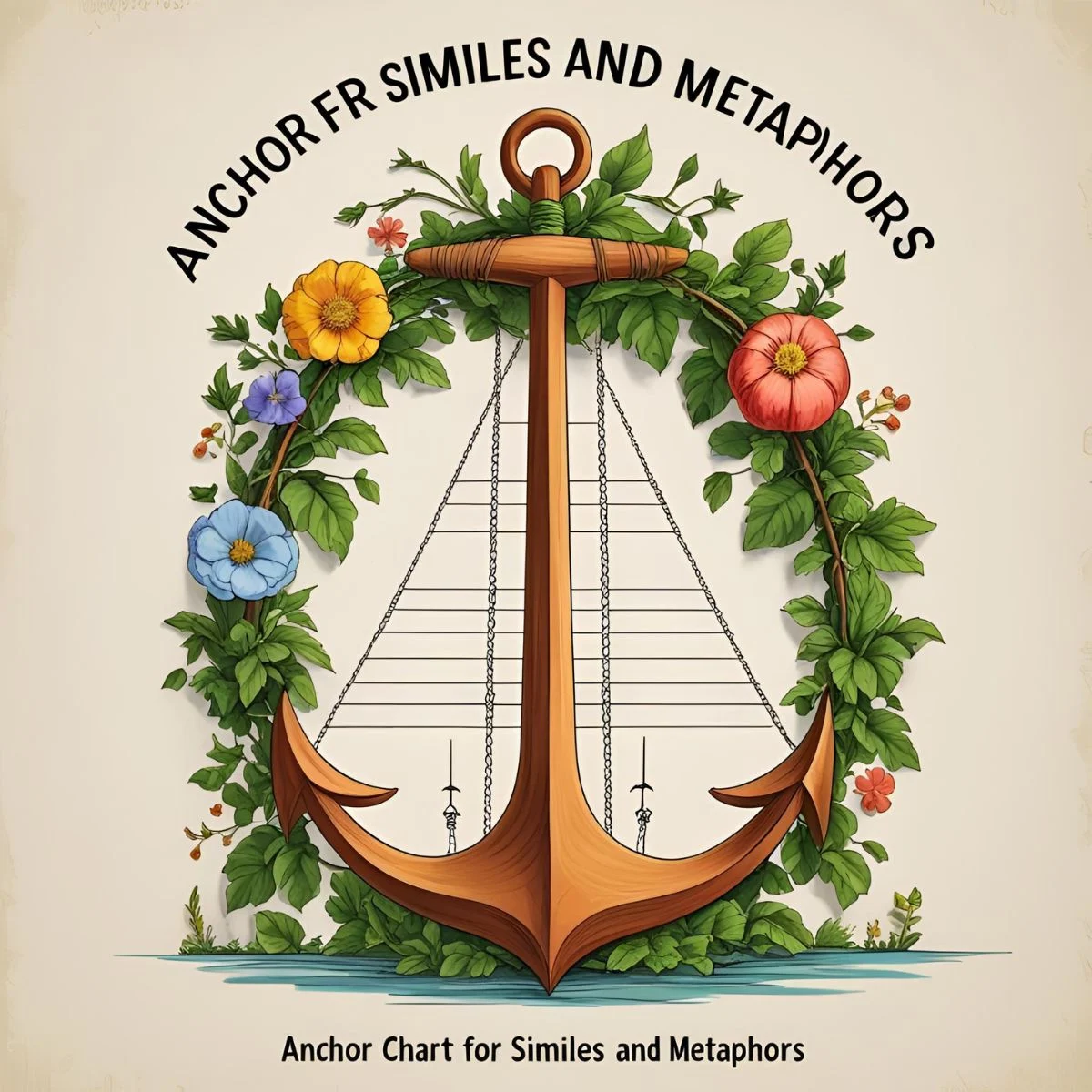Why Similes and Metaphors Light Up Learning ✨
Similes and metaphors are like colorful markers in a teacher’s toolkit, transforming plain language into vibrant, memorable images. Similes compare two unlike things using “like” or “as” (e.g., “Her smile is like sunshine”), while metaphors make direct comparisons without those words (e.g., “Her smile is sunshine”).
These figurative language tools make lessons, stories, and conversations more engaging and relatable, helping students visualize abstract ideas. An anchor chart for similes and metaphors is a classroom superhero, guiding students to understand and create their own comparisons. Ready to make learning pop? Let’s explore 25 similes and metaphors for an anchor chart, organized by theme, to inspire your classroom or personal projects! 🖌️
Similes and Metaphors for Your Anchor Chart: 25 Vivid Examples
These 25 similes and metaphors, tailored for an anchor chart, capture the essence of classroom life, emotions, and creativity. Grouped thematically, each includes a meaning, a contextual example, and a specific application for teaching, writing, or everyday use. Perfect for students, teachers, or anyone crafting lively language!
Comparisons for Classroom Energy 📚
Similes and metaphors for the hustle and bustle of learning.
- Simile: Students buzz like bees in a hive.
Meaning: Students hum with excitement and activity, like bees working together.
Example: In a classroom scene, “The room buzzed like bees in a hive as students tackled group projects.”
Application: Add to an anchor chart to describe lively class discussions or use in a teacher’s newsletter about teamwork. - Metaphor: The classroom is a bubbling cauldron of ideas.
Meaning: The classroom simmers with creative thoughts, like a cauldron brews potions.
Example: In a lesson plan, “Our classroom, a bubbling cauldron, brewed ideas for the science fair.”
Application: Use on an anchor chart to inspire brainstorming or in a student reflection on group work. - Simile: Minds spark like firecrackers during debates.
Meaning: Students’ thoughts ignite with energy, like firecrackers exploding.
Example: In a debate club, “Her mind sparked like a firecracker, lighting up the argument.”
Application: Include on an anchor chart for persuasive writing or use in a speech about critical thinking. - Metaphor: Notebooks are treasure chests of knowledge.
Meaning: Notebooks hold valuable ideas, like chests store gold.
Example: In a writing prompt, “Her notebook, a treasure chest, overflowed with story ideas.”
Application: Use on an anchor chart to encourage note-taking or in a journal prompt about learning. - Simile: Questions fly like arrows in a lively class.
Meaning: Students’ questions shoot out eagerly, like arrows hitting a target.
Example: In a lesson, “Questions flew like arrows as students dug into the history topic.”
Application: Add to an anchor chart for inquiry-based learning or use in a classroom blog.
Comparisons for Focus and Effort 🎯
Similes and metaphors for students’ determination and concentration.
- Simile: Students focus like lasers on tough problems.
Meaning: Students zero in with precision, like lasers cutting through material.
Example: In a math class, “He focused like a laser, slicing through the algebra puzzle.”
Application: Use on an anchor chart for problem-solving or in a study skills workshop description. - Metaphor: Effort is a steamroller, flattening obstacles.
Meaning: Hard work crushes challenges, like a steamroller smooths roads.
Example: In a motivational talk, “Her effort, a steamroller, flattened the essay’s challenges.”
Application: Include on an anchor chart for perseverance or use in a pep talk before exams. - Simile: Minds churn like gears in a study session.
Meaning: Students’ brains work steadily, like gears turning in a machine.
Example: In a study group, “Their minds churned like gears, grinding through biology notes.”
Application: Add to an anchor chart for study habits or use in a group project reflection. - Metaphor: Concentration is a fortress, guarding against distractions.
Meaning: Focus protects students from chaos, like a fortress withstands attacks.
Example: In a teen novel, “Her concentration, a fortress, blocked out the phone’s pings.”
Application: Use on an anchor chart for focus strategies or in a blog about productivity. - Simile: Students grind like coffee beans for success.
Meaning: Students work hard to produce results, like beans ground into coffee.
Example: In a yearbook, “She grinded like coffee beans, brewing an A on her project.”
Application: Include on an anchor chart for effort or use in a social media post about finals.
Comparisons for Creativity 🎨
Similes and metaphors for students’ imaginative and artistic sides.
- Simile: Ideas dance like fireflies in a brainstorm.
Meaning: Creative thoughts flicker brightly, like fireflies in the dark.
Example: In an art class, “Her ideas danced like fireflies, lighting up her sketch.”
Application: Use on an anchor chart for creative writing or in a caption for a school art show. - Metaphor: Minds are kaleidoscopes, twisting thoughts into patterns.
Meaning: Students’ brains create unique ideas, like kaleidoscopes form designs.
Example: In a poetry lesson, “His mind, a kaleidoscope, wove words into vibrant poems.”
Application: Add to an anchor chart for poetry or use in a creative writing prompt. - Simile: Stories bloom like flowers in writing class.
Meaning: Narratives grow beautifully, like flowers opening to the sun.
Example: In a writing workshop, “Her story bloomed like a flower, captivating the class.”
Application: Use on an anchor chart for storytelling or in a student anthology intro. - Metaphor: Imagination is a rocket, blasting into new worlds.
Meaning: Creativity propels students to bold ideas, like a rocket explores space.
Example: In a drama club, “Her imagination, a rocket, launched the play’s wild plot.”
Application: Include on an anchor chart for drama or use in a speech about innovation. - Simile: Thoughts soar like kites in a group project.
Meaning: Ideas rise freely, like kites catching the wind.
Example: In a science fair, “Their thoughts soared like kites, designing a solar model.”
Application: Use on an anchor chart for collaboration or in a project presentation.
Comparisons for Emotions and Connections ❤️
Similes and metaphors for students’ feelings and relationships.
- Simile: Friendships glow like campfires in the lunchroom.
Meaning: Bonds radiate warmth, like campfires bring people together.
Example: In a school story, “Their friendship glowed like a campfire, warming the table.”
Application: Add to an anchor chart for social-emotional learning or use in a yearbook quote. - Metaphor: Hearts are bridges, linking students through laughter.
Meaning: Emotions connect peers, like bridges span rivers.
Example: In a club scene, “Her heart, a bridge, linked the team with her jokes.”
Application: Use on an anchor chart for teamwork or in a speech about community. - Simile: Smiles shine like stars in a kind classroom.
Meaning: Happiness lights up the room, like stars in the night sky.
Example: In a teacher’s note, “Her smile shined like a star, brightening the lesson.”
Application: Include on an anchor chart for positivity or use in a classroom newsletter. - Metaphor: Confidence is a crown, worn proudly in class.
Meaning: Self-assurance stands out, like a crown signifies royalty.
Example: In a debate, “Her confidence, a crown, shone as she argued her point.”
Application: Use on an anchor chart for self-esteem or in a motivational essay. - Simile: Encouragement flows like a river between friends.
Meaning: Support moves freely, like a river nourishes the land.
Example: In a study group, “His encouragement flowed like a river, lifting her spirits.”
Application: Add to an anchor chart for peer support or use in a team reflection.
Comparisons with Cultural Flair 🌍
Similes and metaphors inspired by cultural or historical imagery.
- Simile: Minds are scribes, carving wisdom like ancient scholars.
Meaning: Students record knowledge diligently, like scribes in history.
Example: In a history class, “Her mind, a scribe, carved notes like an Egyptian scholar.”
Application: Use on an anchor chart for history lessons or in a cultural essay. - Metaphor: Curiosity is a lantern, glowing with ancestral wisdom.
Meaning: Inquisitiveness lights up learning, like lanterns at a festival.
Example: In a cultural fair, “Her curiosity, a lantern, glowed with stories of her roots.”
Application: Include on an anchor chart for global studies or use in a diversity speech. - Simile: Ideas drum like rhythms in a cultural project.
Meaning: Thoughts pulse with energy, like drums carry tradition.
Example: In a music class, “His ideas drummed like rhythms, shaping the group’s song.”
Application: Use on an anchor chart for cultural projects or in a festival blog. - Metaphor: Knowledge is a mosaic, piecing together global lessons.
Meaning: Learning blends diverse ideas, like a mosaic forms art.
Example: In a study abroad journal, “Her knowledge, a mosaic, wove lessons from Tokyo.”
Application: Add to an anchor chart for global learning or use in a travel essay. - Simile: Brains spark like alchemists, turning facts into gold.
Meaning: Minds transform information into insights, like alchemists make gold.
Example: In a science fair, “His brain sparked like an alchemist, turning data into a winning project.”
Application: Use on an anchor chart for science or in a post about academic wins.
Creative Examples to Inspire Learning 🎉
These similes and metaphors make anchor charts pop! “Minds spark like firecrackers” captures the thrill of a lively debate, perfect for a classroom poster. “Hearts are bridges” paints a warm picture of friendship, ideal for a social-emotional lesson. Ever thought of your notebook as a “treasure chest”? Try it in a journal entry! Which comparison sparks your imagination—do you see your classroom as a “cauldron” or your focus as a “laser”?
Try This: Pick a simile or metaphor and write a sentence about your day, like “My ideas danced like fireflies in art class.” Share it on a class board or in a notebook!
Practical Applications for Every Classroom 📝
These comparisons can transform teaching and learning:
- Anchor Charts: Display “Questions fly like arrows” to encourage inquiry or “Notebooks are treasure chests” to promote note-taking.
- Writing: Use “Ideas dance like fireflies” in a creative writing prompt or “Confidence is a crown” in a personal essay.
- Teaching: Add “Minds churn like gears” to a lesson plan to describe group work or “Curiosity is a lantern” for cultural discussions.
- Classroom Chats: Say “We’re bubbling cauldrons today!” to hype a brainstorming session or “Smiles shine like stars” to boost positivity.
- Social Media: Post “My brain’s a kaleidoscope of ideas! 🌈” for a project update or “Grinding like coffee beans for finals! ☕” on Instagram.
Challenge: Swap a plain sentence in your next assignment with a simile or metaphor, like “I worked hard” to “My effort was a steamroller, flattening my essay.” See how it grabs attention!
Conclusion: Make Your Anchor Chart Shine 🌟
Similes and metaphors are your classroom’s secret sauce, turning lessons into adventures and words into art. From “minds sparking like firecrackers” to “knowledge as a mosaic,” these comparisons make learning vivid and fun. Create an anchor chart with these ideas, then challenge your students—or yourself—to craft one of your own, like “My brain’s a volcano, erupting with ideas!” Share it on a class wall or tweet it to inspire others. Teaching is a canvas, and similes and metaphors are your paint—create a masterpiece! 🎨



